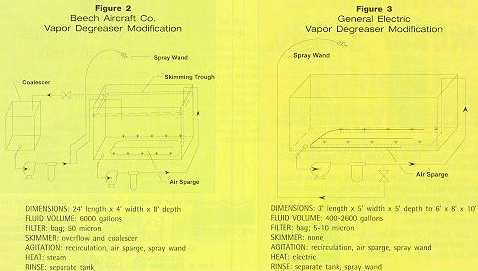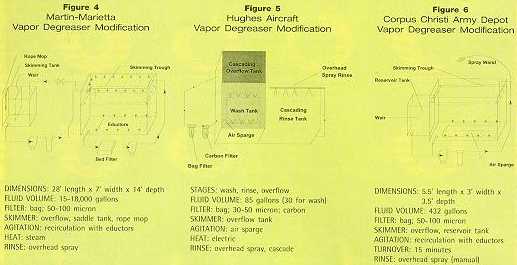| "Precision Cleaning - The Magazine of Critical
Cleaning Technology" Parts Cleaning Technology Transition:
Vapor Degreasers Modified for Aqueous Immersion Cleaning
Chlorofluorocarbons (CFCs) have traditionally been used in the metalworking industry to clean a broad spectrum of substrates, both metallic and nonmetallic. Although these volatile hydrocarbon solvents are sometimes used in cold immersion and/or hand-wipe processes, they are most frequently used in vapor degreaser applications where the chemical is heated to boiling and the cleaning process occurs in the vapor phase. Governments worldwide have initiated aggressive programs to stop the production and subsequent use of chlorinated-fluorinated compounds, however, due to the environmental risks associated with these alleged ozone-depleting substances. Air Quality Boards are also regulating the amount of non-CFC volatile material used. Volatile organic compounds (VOCs) are becoming an everyday concern. Further, the Occupational Safety & Health Administration (OSHA) has instituted vapor exposure limits for virtually all solvents used in cleaning compounds. With the metalworking industry's move away from hydrocarbon solvent technology comes a renewed interest in aqueous cleaners. To minimize capital expenditures required for the transition, users have been creative in modifying "old" systems to meet their cleaning needs. With minimum dollar investment, several companies have converted existing vapor degreasing equipment to immersion cleaning tanks suitable for use with aqueous cleaning technologies. Outlined here are the steps necessary to convert a traditional vapor degreaser tank to an agitated immersion tank for aqueous cleaning. Optional filtration and recycling equipment are also included with actual case histories illustrated.
The Cleaning Process Vapor degreaser equipment is designed to be used with volatile chemicals such as methyl chloroform (1,1,1-trichloroethane, or TCA), trichloroethylene, methylene chloride, or Freon.1
As shown in Figure 1, the chemical is heated to boiling to form vapors, which the part is then exposed to. The hot vapors condense on the cold part, dissolve oily soils, and flush them from the part. Cleaning action continues until the part warms up and condensation stops. This condensation action generally takes approximately 10 minutes, after which the part is removed clean and dry. These hydrocarbon solvents are especially effective on organic soils such as petroleum-based cutting oils, grease, wax, and petrolatums; but less effective on inorganic soils such as fingerprints, water-soluble salts, and road films. Particulate soils such as metal chips and fines are frequently removed by hand detailing with an attached spray wand. New water-based agents are being developed to replace volatile solvents for cleaning metallic and nonmetallic substrates. These aqueous solutions contain water conditioners, varying amounts of alkalinity builders, and a careful selection of organic surfactants as desired for the foam, wetting, and detergency properties required. Since these aqueous cleaners are not volatile, cleaning cannot occur in the vapor phase; chemical exposure takes place via immersion, spray, or hand-wipe methods. Aqueous cleaners remove both organic and inorganic soils in several ways, including:2 solubilizing the soil, chemically reacting it through saponification or chelation, lifting it through surface action or detergency, and/or using mechanical action to displace the soil. Often the aqueous cleaning process involves a combination of these mechanisms. The mechanics as well as equipment used can vary significantly as water-based technology evolves.
Addressing Equipment Needs Keeping health, safety, and environmental issues in mind, the end-user must select a cleaning agent that will remove the majority of soils at a concentration, temperature, and time frame compatible with production needs. He must also select the appropriate equipment required to maximize his cleaning process while staying within budget restrictions. Retrofitting an existing vapor degreaser for aqueous processing begins by converting the chemical tank to an immersion bath. Metal banding can be used if necessary to reinforce a light-gauge tank where the pressures of increased fluid volume are of concern--usually pertinent to very large or deep tanks. Fluid recirculation, air sparging, lightening mixture agitation, and/or ultrasonics are among the methods incorporated to agitate the aqueous fluid. Frequently an existing spray wand is retained for hand detailing if needed. Most systems are also equipped with a means of removing contaminants, accomplished with media filters, skimmers, separate skimming tanks, fluid overflow, coalescers, and/or vacuuming. Microfiltration is occasionally added to enhance fluid recycling. If needed, rinsing capability is also added to the existing tank. Sometimes a spray wand is used to rinse parts as they exit the wash tank; other times a fine spray rinse installed directly over the tank provides steady water flow. Occasionally a separate rinse stage is incorporated. A forced air knife can dry off excess water and facilitate drying.
Conversion Success Stories Beech Aircraft Co. (Wichita, KS) This manufacturer of commercial aircraft components converted to aqueous technology in 1993; replacing TCA. Multi-metals are involved, including aluminum alloys and chromium-conversion coated cadmium plate. A broad spectrum of oily-type soils and shop dirts are being removed. Several small vapor degreasers were converted to immersion tanks. When attempting to convert their large unit, Beech found the tank had too many leaks and was not salvageable. The unit was replaced with a large 304 stainless steel tank to fit into the same space. As shown in Figure 2, the tank measures 24' x 4' x 8' and holds 6000 gallons of aqueous cleaner. Steam heat is applied through external heat exchangers to maintain the cleaning bath at 150-160° F.
Agitation is accomplished with recirculation and air sparge. A spray wand is available for hand detailing if needed. Recirculation is accomplished with two pumps, both with a flow rate of 100 gpm. A third pump has been added to the spray wand for increased pressure. Air sparging is accomplished with compressed air at 2 to 3 psi through a network of piping with one-eighth- to one-quarter-inch holes every 4 to 6 inches. PVC or steel piping is suggested. No nozzles or eductors are used. To remove contaminants and increase bath life, this tank has been equipped with a 50-micron bag filter, an overflow trough, and an oil coalescer. Rinsing is accomplished in a separate tank.
General Electric (Evandale, OH) This company manufactures high nickel alloy turbine vanes and blades for aircraft engines. The primary soil involved is EDM oil along with graphite from the electrodes. The facility has converted five vapor degreasers to aqueous technology since 1992. These 304 stainless steel tanks range in size from 3' x 5' x 5' to 6' x 8' x 10' with aqueous cleaner capacity ranging from 400 to 2600 gallons. The original electric heaters are used to maintain a 140° F bath temperature. As shown in Figure 3, fluid agitation is accomplished with recirculation through a series of nozzles as well as air sparging with compressed air at 2 to 3 psi through a network of piping with holes.3 A spray wand is available on some units for hand detailing as needed. To remove particulates and some oils, each unit is equipped with a polypropylene 5- to 10-micron bag filter in the fluid recirculation line. Coalescers are available but have not been hooked up as yet. One unit is equipped with a spray-wand rinse. The remaining cleaning lines use a separate rinse tank when a rinse is required. Average tank life of the aqueous cleaner baths in these converted vapor degreasers exceeds six months.
Martin-Marietta (Denver, CO) This fabricator of high-technology aerospace components undertook an extensive study of aqueous alkaline cleaners and associated equipment to replace TCA in their cleaning operations. Vapor degreasers had been used to remove gross soils from metal parts prior to chemical processing, including deoxidizing, acid etching for bonding prep, and chem milling.4 It was determined that converting two existing vapor degreasers to aqueous immersion baths was both practical and economical. The quarter-inch 304 stainless steel tank, 28' x 7' x 14' with a fluid capacity of 18,000 gallons, was retrofitted as shown in Figure 4. Steam heat with the heat exchanger frame and plate outside the tank maintains bath temperature at 130° F. Agitation is accomplished with recirculation. Two pumps, each with a flow rate of 200 gpm, are used alternately. Fluid is circulated through a series of 15 eductors on each side for increased turbulence. In-line pressure is routinely maintained in the 25 to 40 psi range with a maximum of 60 psi. A bed filter with 50- to 100-micron paper removes particulates. An overflow trough was added for constant skimming of floating contaminants. A separate saddle tank, used as a skimming tank, incorporates a rope mop to pull the oils out of the bath. The pumps are shut down four hours daily to further enhance contaminant separation and removal. To facilitate rinsing and replacement of evaporated water, a water spray was added over the tank. A second, smaller retrofitted vapor degreaser tank is plumbed to the larger unit. This user is still consuming its initial charge of aqueous cleaner; bath life to date is more than three years.
Hughes Aircraft (La Grange, GA) This manufacturer of missile components has converted a Deltasonics vapor degreaser for use with aqueous technology. As shown in Figure 5, this 304 stainless 85-gallon-capacity unit is equipped with three separate tanks:
The system uses electric heat; agitation is accomplished by air sparge. The ultrasonic transducers have been disconnected.
Corpus Christi Army Depot (Corpus Christi, TX) This military facility4 has acquired numerous agitating, high-pressure turntable, and ultrasonic washers (with costs ranging from $14,000 to $75,000) for use with aqueous technology to clean a variety of missile components. An existing vapor degreaser has also been converted to an 864-gallon-capacity immersion cleaning system for use with an aqueous cleaner. This equipment's conversion had a materials cost of $3054 and a labor cost of $2000 for a total expenditure of just over $5000. As Figure 6 shows, agitation is accomplished via recirculation with three-eighths- to three-quarter-inch eductors spaced approximately 2 feet apart and angled at 45 degrees upward. A pump capacity of 29 gpm yields a bath turnover every 15 minutes. A 50- to 100-micron bag filter removes particulates while a separate attached reservoir tank collects tramp oils. A skimmer removes these oils from the reservoir tank. An overhead water-spray rinsing system installed with wide-patterned nozzles spaced 6 inches apart is controlled manually. Since this user's retrofit is scheduled for completion by year's end, fluid tank life has not been determined.
Benefits Reaped Martin-Marietta, Beach Aircraft Co., General Electric, and Hughes Aircraft all report comparable or superior cleaning performance with an aqueous cleaner used in conjunction with their modified equipment. In all cases the aqueous cleaner bath has proven to be more economical than the previous process. Bath life has been extended and waste generation has been reduced. Toxic chemical releases have been reduced as much as 90 percent. As reported by Martin-Marietta,5 the cost of converting existing vapor degreasing equipment was approximately one-third that of a new state-of-the-art vapor degreaser. The modifications were custom-designed to meet the user's cleaning requirements. Corpus Christi Army Depot was able to retrofit its unit for just over $5000, approximately one-third the cost of new cleaning lines elsewhere in the facility. Each of these precision cleaners have successfully incorporated aqueous cleaning technology to reduce or eliminate CFC consumption. Using existing equipment to make this technology change reduces the need for major capital expenditures. Compliance need not be cost prohibitive.
References 1. Freon is a registered trade name of DuPont. 2. Quitmeyer, J.A., "Aqueous Cleaners Challenge Chlorinated Solvents," Pollution Engineering, December, 1991. 3. Sisbarro, T.A., "Degreaser Conversion Layout," Environmental Closure Systems Inc., Reynoldsburg, OH (Drawing, 1992). 4. Cooper, E.C., "Corpus Christi Army Depot; Trico/Freon--113 Replacement," 1994. 5. Snyder, J.T., "Aqueous Degreasing a Viable Alternative to Vapor Degreasing," Martin-Marietta Astronautics Group, 1991.
About the Author JoAnn A. Quitmeyer, with more than 20 years experience formulating coolants and cleaners for the metalworking industry, is currently a senior research associate for the Metalworking Fluids group of the Container Products Division of W.R. Grace & Co.--Conn. (Lexington, MA). Author of numerous articles and papers relating to aqueous cleaning and lubrication, she is an active member of STLE, SME, and SAMPE. |


